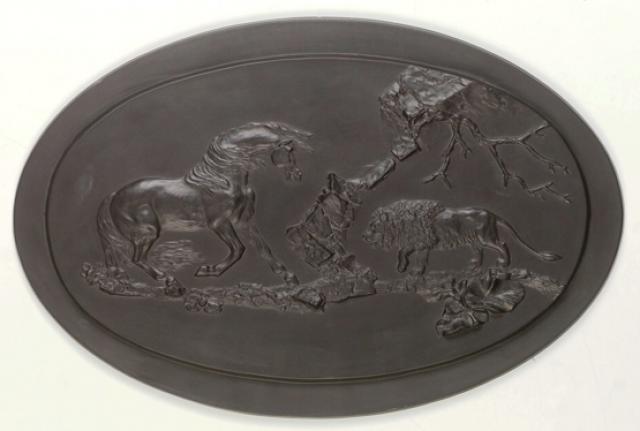Wedgwood and Artists: Black Basalt Plaque ‘The Frightened Horse’
Today, Stubbs is regarded as the greatest British painter of horses and his renowned ‘Anatomy of a Horse’ was published in 1766. Stubbs investigated the possibility of painting with enamel colours on various media including copper and, by 1775, his search for a ceramic ‘support’ was brought to the attention of Wedgwood’s Ornamental Ware partner, Thomas Bentley.
Josiah was extremely enthusiastic about the proposal to produce ceramic tablets or plaques to be used as an artist’s canvas, but the reality was that the production of large sized plaques took several years to accomplish. Stubbs was keen to receive the plaques as soon as possible, causing Wedgwood to write to Bentley that Stubbs ‘shall be gratified, but large tablets are not the work of a day.’
The ceramic medium chosen to produce the plaques was probably a low-fired version of the so-called terracotta body, which was suitable for large sized objects. A thin-light glaze was applied to the surface to seal it and make it suitable for the application of enamel colours. Several notable subjects are known on Wedgwood/Stubbs plaques – including a portrait of Richard Wedgwood, Josiah’s father-in-law. In part payment for the ceramic plaques produced by the factory, Josiah asked Stubbs to work on a portrait of the Wedgwood family and on modelling two bas-relief scenes: ‘The Frightened Horse’ and a companion piece ‘The Fall of Phaeton’. The former subject was modelled at Stubbs’ own suggestion from his own engraving of ‘The Lion and the Horse’. Josiah was greatly surprised at the mastery of the subject produced by Stubbs and his quick adaptation to the use of potters’ tools.
On 1 August 1780, clay tablets had been prepared for Stubbs on which to produce his initial model and, by 13 August, the subject of the ‘Frightened Horse’ had been chosen. Wedgwood wrote on that day: ‘…he [Stubbs] is now laying in the horse whilst I am writing a few letters this good Sunday morning.’ By 21 August Stubbs had completed the model and Josiah was writing to Bentley promising a copy ‘…very soon either in blue & white [jasper], or to save time in one colour.’ The ‘one colour’ referred to was black basalt.
The subject has proved to be enduringly popular and has appeared at regular intervals since the 18th century.
